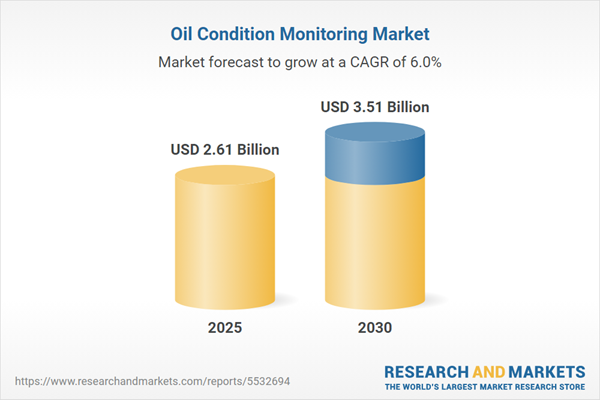Speak directly to the analyst to clarify any post sales queries you may have.
Oil condition monitoring has rapidly emerged as a strategic focal point for asset-intensive industries seeking to enhance equipment reliability and reduce operational risks. As organizations shift from reactive to predictive maintenance, advanced oil condition monitoring solutions are enabling smarter, data-driven decisions that drive measurable improvements across fleets and facilities.
Market Snapshot: Size, Growth, and Investment Trends
The oil condition monitoring market is on a solid growth trajectory, rising from USD 2.47 billion in 2024 to USD 2.61 billion in 2025, and is forecast to reach USD 3.51 billion by 2030. The sector is expanding at a CAGR of 5.99%, underpinned by continuous technology innovation, rising demand for reliability engineering, and increasing emphasis on data-driven maintenance strategies. Organizations are prioritizing real-time diagnostics and adopting integrated service models, reinforcing the importance of oil condition monitoring in critical operations across sectors worldwide.
Scope & Segmentation: Detailed Market Coverage
- Offering: Instrument, Services, Software, Offline Instruments, Online Instruments
- Oil Type: Bio Based Oil, Mineral Oil, Synthetic Oil
- Monitoring Parameter: Acidity (TAN), Oxidation, Particle Contamination, Temperature, Viscosity, Water Content
- Application: Compressor, Engine, Gearbox, Hydraulic System, Turbine
- End User Industry: Aerospace, Automotive, Commercial Vehicle, Passenger Vehicle, Manufacturing, Marine, Oil & Gas, Power Generation, Hydro Power, Nuclear Power, Renewable Power, Thermal Power
- Region: Americas, North America, United States, Canada, Mexico, Latin America, Brazil, Argentina, Chile, Colombia, Peru, Europe, Middle East & Africa, United Kingdom, Germany, France, Russia, Italy, Spain, Netherlands, Sweden, Poland, Switzerland, United Arab Emirates, Saudi Arabia, Qatar, Turkey, Israel, South Africa, Nigeria, Egypt, Kenya, Asia-Pacific, China, India, Japan, Australia, South Korea, Indonesia, Thailand, Malaysia, Singapore, Taiwan
- Key Companies: ALS Limited, Avenisense S.A. by WIKA TECH S.A.S., Bureau Veritas SA, C.C. Jensen A/S, Chevron Corporation, CM Technologies GmbH, David Brown Santasalo, Des‑Case Corporation by The Timken Company, Eaton Corporation plc, Emerson Electric Co., eralytics GmbH, Eurofins Scientific SE, Exxon Mobil Corporation, Honeywell International Inc., Intertek Group plc, Micromen Technologies Inc., Neptunus Power Plant Services Pvt. Ltd., Parker Hannifin Corporation, Poseidon Systems, LLC, Rheonics Group, SGS S.A., Shell PLC, Tan Delta Systems plc., TotalEnergies SE, Baker Hughes Company, Hitachi, Ltd., HYDAC International GmbH, WearCheck International, SKF AB, METTLER TOLEDO, Fluke Corporation by Fortive Corporation
Key Takeaways: Strategic Insights for Decision-Makers
- Hybrid testing models combining online and offline analysis are enhancing early detection of oil degradation, enabling more proactive interventions and optimizing asset lifecycles.
- Analytics-driven decision systems now standardize monitoring outputs across complex fleets, supporting consistent maintenance actions and increasing operational transparency.
- Sustainability goals and regulatory pressures are accelerating the adoption of advanced monitoring, reducing waste, and minimizing compliance risks in high-stakes environments.
- The evolution of service models, including bundled offerings and subscription-based analytics, is transforming how buyers manage lifecycle costs and supplier relationships.
- Segment-specific needs—from unique oil chemistries to application-focused diagnostics—are driving targeted product development and tailored go-to-market strategies for vendors and service firms.
Tariff Impact: How 2025 US Tariff Changes Reshape Supply Chains
Recent US tariff adjustments have begun to affect sourcing strategies and supplier relationships throughout the oil condition monitoring ecosystem. Organizations are increasingly prioritizing local procurement, dual-sourcing programs, and regional partner qualification to mitigate cost volatility and manage lead-time risks. Service providers and OEMs are revising pricing structures and enhancing field-serviceability to address import uncertainties. Furthermore, these shifts have created fresh opportunities for regional manufacturers, who are responding with localized support and integrated service offerings tailored to current market demands.
Methodology & Data Sources
This report combines interviews with maintenance and reliability experts, technical validation of both laboratory and online instruments, and a robust review of industry standards and technical literature. Practitioner input and comparative technology assessment ensure balanced coverage of solution performance, while secondary validation ensures all findings are grounded in the latest market realities.
Why This Report Matters
- Helps leaders benchmark their technology investments against the evolving landscape of oil condition monitoring.
- Supports informed procurement decisions by clarifying supplier dynamics and technology integration opportunities.
- Enables companies to align monitoring strategies with broader reliability, compliance, and ESG objectives.
Conclusion
Integrated oil condition monitoring solutions that balance instrumentation, services, and analytics now underpin operational resilience for asset-intensive industries. Tailored approaches and regionalized supply chains deliver adaptability, empowering organizations to optimize maintenance and sustainability outcomes.
Additional Product Information:
- Purchase of this report includes 1 year online access with quarterly updates.
- This report can be updated on request. Please contact our Customer Experience team using the Ask a Question widget on our website.
Table of Contents
3. Executive Summary
4. Market Overview
7. Cumulative Impact of Artificial Intelligence 2025
Companies Mentioned
The companies profiled in this Oil Condition Monitoring market report include:- ALS Limited
- Avenisense S.A. by WIKA TECH S.A.S.
- Bureau Veritas SA
- C.C. Jensen A/S
- Chevron Corporation
- CM Technologies GmbH
- David Brown Santasalo
- Des‑Case Corporation by The Timken Company
- Eaton Corporation plc
- Emerson Electric Co.
- eralytics GmbH
- Eurofins Scientific SE
- Exxon Mobil Corporation
- Honeywell International Inc.
- Intertek Group plc
- Micromen Technologies Inc.
- Neptunus Power Plant Services Pvt. Ltd.
- Parker Hannifin Corporation
- Poseidon Systems, LLC
- Rheonics Group
- SGS S.A.
- Shell PLC
- Tan Delta Systems plc.
- TotalEnergies SE
- Baker Hughes Company
- Hitachi, Ltd.
- HYDAC International GmbH
- WearCheck International
- SKF AB
- METTLER TOLEDO
- Fluke Corporation by Fortive Corporation
Table Information
| Report Attribute | Details |
|---|---|
| No. of Pages | 186 |
| Published | November 2025 |
| Forecast Period | 2025 - 2030 |
| Estimated Market Value ( USD | $ 2.61 Billion |
| Forecasted Market Value ( USD | $ 3.51 Billion |
| Compound Annual Growth Rate | 5.9% |
| Regions Covered | Global |
| No. of Companies Mentioned | 32 |









